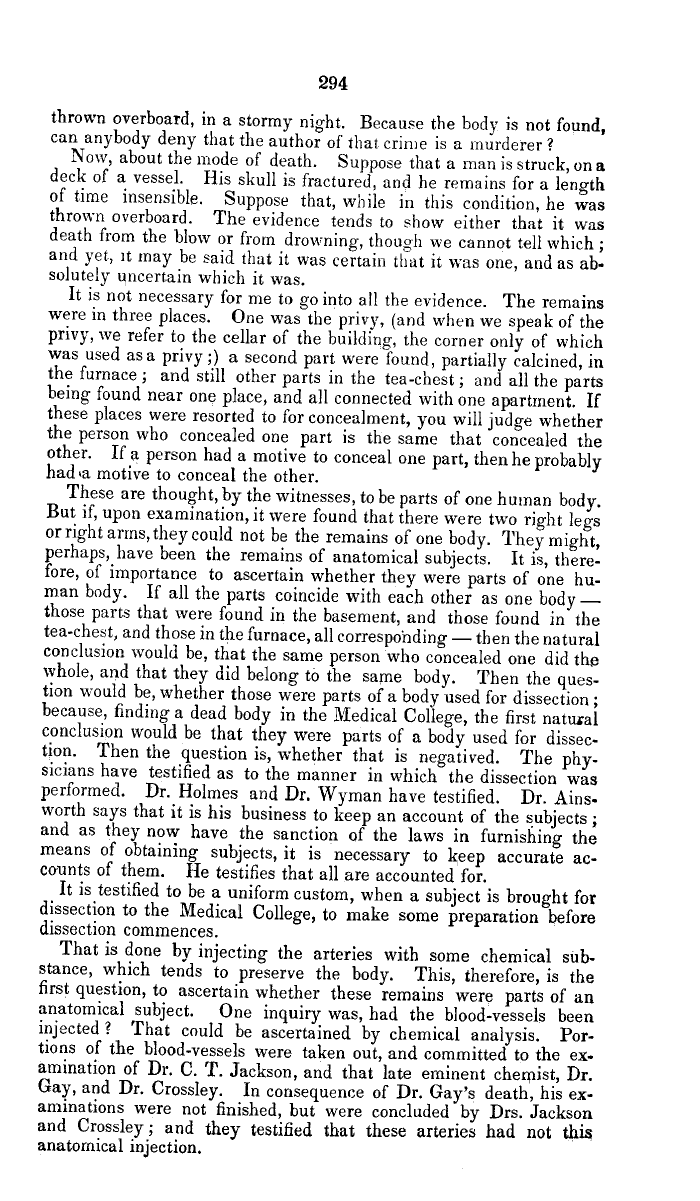|
294
thrown overboard, in a stormy night. Because the body is not found,
can anybody deny that the author of that crime is a murderer ?
Now, about the mode of death. Suppose that a man is struck, on a
deck of a vessel. His skull is fractured, and be remains for a length
of time insensible. Suppose that, while in this condition, he was
thrown overboard. The evidence tends to show either that it was
death from the blow or from drowning, though we cannot tell which ;
and yet,, it may be said that it was certain that it was one, and as ab-
solutely uncertain which it was.
It is not necessary for me to go into all the evidence. The remains
were in three places. One was the privy, (and when we speak of the
privy, we refer to the cellar of the building, the corner only of which
was used as a privy;) a second part were found, partially calcined, in
the furnace ; and still other parts in the tea-chest ; and all the parts
being found near one place, and all connected with one apartment. If
these places were resorted to for concealment, you will judge whether
the person who concealed one part is the same that concealed the
other. If a person had a motive to conceal one part, then he probably
had,a motive to conceal the other.
These are thought, by the witnesses, to be parts of one human body.
But if, upon examination, it were found that there were two right legs
or right arms, they could not be the remains of one body. They might,
perhaps, have been the remains of anatomical subjects. It is, there-
fore, of importance to ascertain whether they were parts of one hu-
man body. If all the parts coincide with each other as one body -
those parts that were found in the basement, and those found in the
tea-chest, and those in the furnace, all corresponding - then the natural
conclusion would be, that the same person who concealed one did the
whole, and that they did belong to the same body. Then the ques-
tion would be, whether those were parts of a body used for dissection ;
because, finding a dead body in the Medical College, the first natural
conclusion would be that they were parts of a body used for dissec-
tion. Then the question is, whether that is negatived. The phy-
sicians have testified as to the manner in which the dissection was
performed. Dr. Holmes and Dr. Wyman have testified. Dr. Ains-
worth says that it is his business to keep an account of the subjects ;
and as they now have the sanction of the laws in furnishing the
means of obtaining subjects, it is necessary to keep accurate ac-
counts of them. He testifies that all are accounted for.
It is testified to be a uniform custom, when a subject is brought for
dissection to the Medical College, to make some preparation before
dissection commences.
That is done by injecting the arteries with some chemical sub-
stance, which tends to preserve the body. This, therefore, is the
first question, to ascertain whether these remains were parts of an
anatomical subject. One inquiry was, had the blood-vessels been
injected ? That could be ascertained by chemical analysis. Por-
tions of the blood-vessels were taken out, and committed to the ex-
amination of Dr. C. T. Jackson, and that late eminent chemist, Dr.
Gay, and Dr. Crossley. In consequence of Dr. Gay's death, his ex-
aminations were not finished, but were concluded by Drs. Jackson
and Crossley; and they testified that these arteries had not this
anatomical injection.
|

